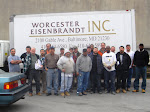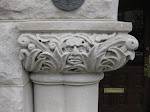
There are a lot of ways that one can gather evidence for a restoration project. Looking at the remaining original materials is one. "Reading" an historic building is not simple and requires quite a bit of knowledge in the history of architecture and building technology. It helps to know about the period differences in nails and other fasteners, hardware, molding profiles and construction techniques. The complication is that so many people added and changed a particular historic building through its life, so it can be very difficult to tell when and where those changes occurred. Every now and then, however, you get lucky and find an historic photograph.
While the iconic image of the Thomas Point Shoal Lighthouse has been captured thousands of times, only a few historic images exist. Those images are going to prove invaluable to the restoration of the structure. Because the lighthouse suffers from such severe weather, it has been deteriorating at a rapid rate since it was built. Repairs have been continually made by lighthouse keepers from both the U. S. Lighthouse Service and the U. S. Coast Guard as

well as numerous volunteers. These repairs have been made with limited resources and to act as improvements. Like any historic structure, repairs have altered the original appearance of the building. Much of the physical evidence has been lost to repair after repair after repair.
All of this makes these photographs very important. There are two in particular that interest me. The first is the earliest known photograph of the lighthouse. It was taken by Major Jared Smith on the 18th of August, 1885. There are several noticeable differences between today's lighthouse and the 1885 lighthouse, but the most important to me is the difference in the railings. The 1885 railings are taller and include a round railing above the lower sqare railing and pickets. The posts are curved on the outboard side and the round rail, or pipe, runs through a hole drilled through the wood.
The taller raili

ng apparently lasted into the 20th century as evidenced by the other historic photograph. This one is of Assistant Lighthouse Keeper Earl C. Harris. It was taken sometime in the 1930's on the perimeter deck of the lighthouse. Behind him is the railing, including the taller rail. While some of the detail is hard to discern, it provides the best evidence of the rail's appearance that we have. Granted, at this point the railing is 50 years old and has, doubtlessly, been repaired several times.
Whether or not the railing gets restored to its 1885 appearance has yet to be determined. The priority for the U. S. Lighthouse Society is the preservation of the structure. They will also have to determine the dates of interpretation for the deck. It may be that the current railing design is the most appropriate. There are still many decisions to be made before deciding if the railing gets changed, but there is evidence if an historic railing replication is desired. Not every property owner is lucky enough to find historic photographs of their building. In fact, more often than not, historic images don't exist. When they do, they can be very valuable resources.
If you are interested in the preservation of the Thomas Point Shoal Lighthouse please visit their website:
http://www.thomaspointlighthouse.org/1885 Lighthouse photograph from the National Archives- Photograph 26-LG-25-54
Photograph of Earl C. Harris courtesy of the U. S. Lighthouse Society
 t isn't just about historic preservation and architectural conservation. We also make exhibits and props for museums. One of our latest projects involves exhibit pieces for the new visitor's center at Fort McHenry National Monument and Historic Shrine.
t isn't just about historic preservation and architectural conservation. We also make exhibits and props for museums. One of our latest projects involves exhibit pieces for the new visitor's center at Fort McHenry National Monument and Historic Shrine. 
 k like an original 19th century projectile. This one is just for viewing purposes, but wouldn't it be cool to make a working one? I don't know that I would have the nerve to light the fuse!
k like an original 19th century projectile. This one is just for viewing purposes, but wouldn't it be cool to make a working one? I don't know that I would have the nerve to light the fuse!











